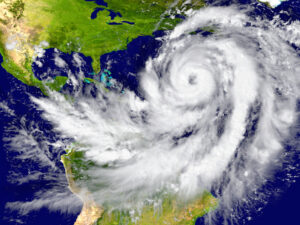Preparing for the 2024 Hurricane Season: A Guide for East Coast Homeowners
As the 2024 hurricane season approaches, homeowners along the East Coast of the United States must take proactive steps to protect their properties. States like North Carolina, South Carolina, Georgia, and Florida are particularly vulnerable to hurricanes, making it essential for residents to prepare adequately. This article outlines the necessary steps to prepare for the season, secure the right homeowners insurance, and understand the importance of windstorm coverage.
1. Assess and Strengthen Your Home’s Structure
- Roof Inspection: Ensure your roof is in good condition, as it’s the first line of defense against storms. Consider installing hurricane straps or clips to reinforce the roof structure.
- Windows and Doors: Install storm shutters or impact-resistant windows and doors. These can prevent wind and debris from entering your home.
- Garage Doors: Strengthen garage doors, as they can be a weak point during hurricanes. Reinforced doors can prevent wind from lifting the roof.
- Outdoor Items: Secure or store outdoor furniture, decorations, and equipment. These items can become dangerous projectiles in high winds.
2. Create a Disaster Preparedness Plan
- Emergency Kit: Assemble a kit with essentials such as water, non-perishable food, medications, batteries, and first-aid supplies.
- Evacuation Plan: Know your evacuation routes and have a plan for where you will go if an evacuation order is issued. Ensure all family members know the plan.
- Important Documents: Store important documents like identification, insurance policies, and property deeds in a waterproof container.
3. Secure the Right Homeowners Insurance Coverage
Finding the right homeowners insurance is crucial, especially in hurricane-prone areas. Here’s how to ensure you have adequate coverage:
- Standard Homeowners Insurance: A standard policy typically covers the structure of your home, personal belongings, liability protection, and additional living expenses. However, it may not cover flood or windstorm damage.
- Flood Insurance: Standard policies do not cover flood damage, so it’s essential to purchase a separate flood insurance policy. The National Flood Insurance Program (NFIP) offers coverage, or you can opt for private flood insurance.
- Windstorm Insurance: Wind damage caused by hurricanes may not be fully covered under standard policies in certain high-risk areas. Homeowners may need a separate windstorm insurance policy or endorsement, especially in coastal regions.
- Loss of Use Coverage: This covers additional living expenses if you are displaced from your home due to hurricane damage. It’s vital to ensure this coverage is adequate to cover potential costs.
4. Best Homeowners Insurance Coverage in NC, SC, GA, and FL
Each state has specific considerations for homeowners insurance due to varying regulations and risks:
- North Carolina: The North Carolina Insurance Underwriting Association (NCIUA) offers windstorm coverage. Private insurers may exclude wind and hail coverage, so check your policy details and consider a separate windstorm policy if necessary.
- South Carolina: The South Carolina Wind and Hail Underwriting Association (SCWHUA) provides coverage in coastal areas where private insurers may exclude wind damage. Consider additional flood insurance as well.
- Georgia: While not as hurricane-prone as its neighbors, Georgia still faces risks. Ensure your policy covers wind damage, and consider flood insurance, especially in coastal areas.
- Florida: Given its high risk, Florida homeowners may need to purchase separate windstorm policies. The Florida Windstorm Underwriting Association (FWUA) offers coverage, and it’s crucial to check if your policy includes or excludes windstorm damage.
5. Understanding Windstorm Coverage
Windstorm coverage is essential for protecting your home from hurricane-related damage. Here’s what you need to know:
- Deductibles: Windstorm policies often come with separate deductibles, which can be a percentage of your home’s insured value. Understand your deductible amount and ensure you have funds available if needed.
- Covered Perils: Windstorm coverage typically includes damage from high winds, hail, and flying debris. However, it may not cover water damage from flooding unless specified.
- Policy Limits: Review the limits on your windstorm coverage to ensure they are sufficient to rebuild or repair your home in the event of significant damage.
6. Finally Prepared
Preparing for the hurricane season involves more than just securing your home; it requires comprehensive insurance coverage tailored to your location and risk level. Homeowners in North Carolina, South Carolina, Georgia, and Florida should review their policies, consider additional windstorm and flood coverage, and ensure they have a solid disaster preparedness plan. By taking these steps, you can safeguard your home and family against the unpredictable nature of hurricanes.


No comments yet.